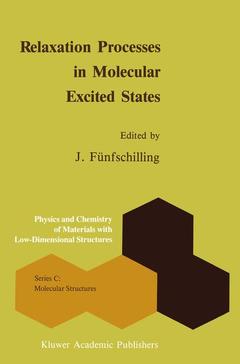Relaxation Processes in Molecular Excited States, 1989 Physics and Chemistry of Materials with C: Series, Vol. 2
Langue : Anglais
Coordonnateur : Fünfschilling J.

Relaxation phenomena of excited molecular states are abundant in all nature. They mediate such key processes as photochemical reactions or even the pathways of ordinary chemical reactions. However, for a long time the main research in electronic relaxation processes was concerned with anorganic solids, in part because of their great technological importance (photography, semiconductors ... ) in part also because these compounds were the "workhorses" of the solid state physicists. In the last 30 years, there was a steadily increasing interest in organic molecular systems, first in molecular crystals and later in all forms of molecular solids (glasses, polymers, membranes, ... ). The present volume combines papers on quite different types of relaxation phenomena: the type of solid studied, the electronic states involved, the physical processes responsible for the relaxations are all different. Nevertheless, after reading this book, a more clear and complete picture of the phenomenon "relaxa tion" emerges that proves that this volume is more than just a collection of individual articles. The volume starts with the paper "Spin-lattice and spin-spin relaxation in photo-excited triplet states in molecular crystals" by Jan Schmidt. Even in these seemingly simple systems of isolated guest molecules in a single crystal host, the relaxation phenomena are quite involved and a very thorough investigation is necessary to find the key relaxation processes. The end of the article provides a bridge to the following paper: it treats interactions of two molecules (dimers), where resonant interactions become important and lead to new, characteristic relaxation processes.
Spin-Lattice and Spin-Spin Relaxation in Photo-Excited Triplet States in Molecular Crystals.- 1. Introduction.- 2. The Theoretical Model.- 3. Experimental.- 3.1. The Measurement of the Spin-Lattice Relaxation Rates.- 3.2. The Measurement of the Spin-Spin Relaxation Rates.- 3.3. The Experimental Arrangements.- 4. Experimental Studies on Spin-Lattice and Spin-Spin Relaxation in Triplet State Molecules in Chemically Mixed Crystals.- 4.1. The System Naphthalene in Durene.- 4.2. Naphthalene-h8 in Naphthalene-d8.- 4.3. Quinoxaline in Durene.- 4.4. Quinoxaline-h6 in Naphthalene-d8.- 4.5. Anthraquinone-h8 in n-Heptane and Anthraquinone-h8 in Anthraquinone-d8.- 4.6. Aniline-d7 in p-Xylene-d10.- 5. Experimental Studies on Spin-Lattice and Spin-Spin Relaxation in the Triplet State of Naphthalene Dimers.- 6. Conclusions.- 7. Acknowledgement.- The Dynamics of One-Dimensional Triplet Excitons in Molecular Crystals.- 1. Introduction.- 2. Review of the Recent Literature.- 3. Triplet Excitons.- 4. The Systems TCB and p-DCB.- 4.1. The Energy Levels of Isolated TCB and p-DCB Molecules.- 4.2. One-Dimensional Triplet Excitons in TCB.- 5. Experimental.- 6. The Dynamic Properties of Triplet Excitons in TCB.- 6.1. The Scattering Process among the Exciton k States.- 6.2. The Theoretical Model for the Exciton Scattering.- 6.3. Impurities and Traps and Their Relation to the Scattering Mechanism.- 6.4. Intra- or Interchain Scattering? A Study of the Spin-Lattice Relaxation in the Presence of a Magnetic Field.- 6.5. The Width ?k of the Triplet Exciton Wave Packets.- 6.6. Relaxation of Vibrationally Excited Triplet Excitons in TCB.- 7. The Dynamical Properties of Triplet Excitons in p-DCB.- 7.1. Introduction.- 7.2. Experimental Results.- 7.3. Discussion.- 7.4. Conclusion.- 8. Summary.- 9. Acknowledgement.- Spectral Hole-Burning in Crystalline and Amorphous Organic Solids. Optical Relaxation Processes at Low Temperature.- 1. Introduction to Hole-Burning.- 1.1. Basic Concepts.- 1.2. Mechanisms.- 2. Experimental.- 2.1. Methods and Techniques.- 2.2. Pitfalls in the Determination of the Homogeneous Linewidth.- 3. Organic Systems Studied.- 3.1. Porphyrins and Biological Systems.- 3.2. Intermolecular and Two-Photon PHB Systems.- 3.3. Non-Photochemical Hole-Burning (NPHB) Systems.- 4. Applications.- 4.1. Molecular Mixed Crystals.- 4.2. Amorphous Solids.- 5. Summary and Conclusions.- 6. Acknowledgements.- Relaxation Theory Applied to Scattering of Excitations and Optical Transitions in Crystals and Solids.- 1. Introduction.- 2. Theory.- 2.1. The Redfield Equations.- 2.2. Simple Models.- 3. Relaxation and Scattering of Excitations at Low Temperature.- 3.1. Dimer Triplet States.- 3.2. One-Dimensional Triplet Excitons.- 3.3. Conclusion.- 4. Optical Hole-Burning in Glasses and Crystals.- 4.1. Photochemical Hole-Burning in Crystals.- 4.2. Hole-Burning in Glasses.- 5. Concluding Remarks.
Date de parution : 10-2011
Ouvrage de 286 p.
15.5x23.5 cm
Disponible chez l'éditeur (délai d'approvisionnement : 15 jours).
Prix indicatif 52,74 €
Ajouter au panierThème de Relaxation Processes in Molecular Excited States :
Mots-clés :
chemical reaction; crystal; molecular solid; polymer; scattering; semiconductor
© 2024 LAVOISIER S.A.S.



